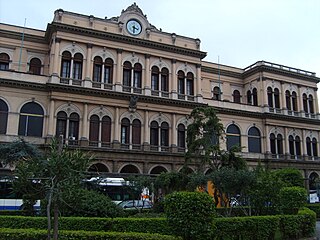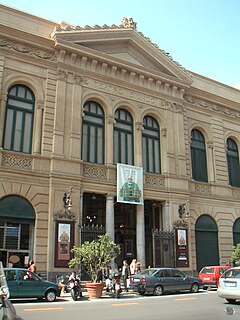
Alcamo is the fourth-largest town in the province of Trapani in Sicily, with a population of 45,374 inhabitants. It is on the borderline with the Metropolitan City of Palermo at a distance of about 50 kilometres from Palermo and Trapani.

Vincenzo Scamozzi was an Italian architect and a writer on architecture, active mainly in Vicenza and Republic of Venice area in the second half of the 16th century. He was perhaps the most important figure there between Andrea Palladio, whose unfinished projects he inherited at Palladio's death in 1580, and Baldassarre Longhena, Scamozzi's only pupil.

Sant'Angelo is the eleventh historic district or rione of Rome, Italy, located in Municipio I. Often written as rione XI - Sant'Angelo, it has a coat of arms with an angel on a red background, holding a palm branch in its left hand. In another version, the angel holds a sword in its right hand and a scale in its left.
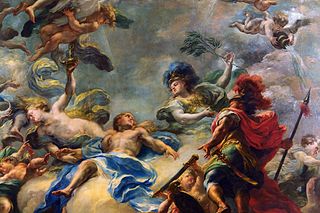
Giacomo del Pò, also spelled del Po, was an Italian painter of the Baroque. He was born in Palermo, the son of Pietro del Pò who was also his teacher.

Arnoldo Foà was an Italian film actor. He appeared in more than 130 films between 1938 and 2014.

Francesco Mancini was an Italian painter whose works are known between 1719 and 1756. He was the pupil of Carlo Cignani.
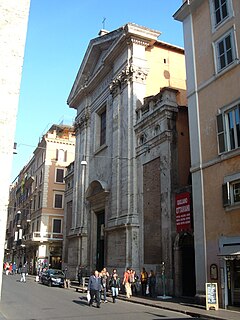
Gesù e Maria is a Baroque church located on Via del Corso in the Rione Campo Marzio of central Rome, Italy. It faces across the street the similarly Baroque facade of San Giacomo in Augusta.

The original Palazzo Bentivoglio was a palace in Bologna, destroyed by the mob in 1507. A second palace by the same name was built nearby, and is still standing.

Giuseppe Velasquez, Velasques or Velasco was an Italian painter, active in a Neoclassic style.

Via dei Coronari is a street in the historic center of Rome. The road, flanked by buildings mostly erected in the 15th and the 16th century, belongs entirely to the rione Ponte and is one of the most picturesque roads of the old city, having maintained the character of an Italian Renaissance street.

The Praetorian Palace, also known as Palace of the Eagles, is a palace of Palermo. The building has an important role in the political life of the city, since it houses the mayor and the offices of the municipality of Palermo. It is located in the heart of the historic centre, between Via Maqueda, Piazza Pretoria and Piazza Bellini, in the same area of other well-known architectural landmarks like the Fontana Pretoria, the Baroque church of Santa Caterina and the Medieval churches of Martorana and San Cataldo.
The following is a timeline of the history of the city of Catania in the Sicily region of Italy.
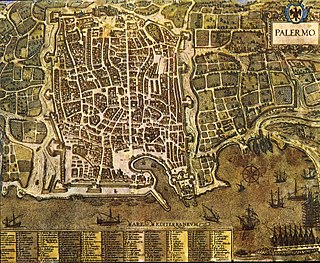
The Cassaro is the most ancient street of Palermo. Following the unification of Italy, it has been officially renamed Via Vittorio Emanuele II, but the old and distinctive name is still in use. The street is rooted in the age of the foundation of Palermo by the Phoenicians. It provides access to a number of important sights, including the Royal Palace and the Cathedral, two UNESCO World Heritage Sites.

Via Maqueda, also known as "Strada Nuova", is an important street of Palermo. Together with the Cassaro, it represents the main axis of the historic centre and provides access to a number of important sights, including Teatro Massimo and Fontana Pretoria. The street is named after the Viceroy of Sicily Bernardino de Cárdenas y Portugal, Duque de Maqueda.

Piazza Marina is a square of Palermo. It is located down the Cassaro street, in the quarter of the Kalsa, within the historic centre of Palermo. The square is dominated by the great Garibaldi Garden.
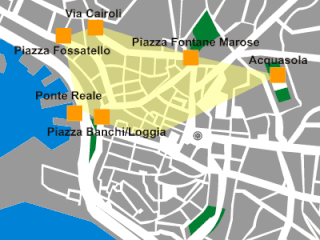
Maddalena is a neighbourhood in the old town of the Italian city of Genoa. It was one of the six sestieri of ancient Genoa. At present it is part of the Genoa's city Municipio I.

The following outline is provided as an overview of and topical guide to Palermo:

